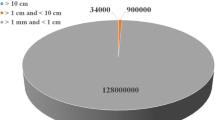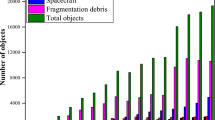Abstract
Protective shields are indispensable for protecting the satellites components from debris impact. Proper evaluation of the response of these shields is important. High velocity impact simulations were conducted to ascertain the response of single bumper Whipple shields used as satellite shields. The study was conducted with the Abaqus explicit solver with the smooth particle hydrodynamics (SPH) framework. A simple damage-based failure model was able to capture the fragmentation as well as the penetration of the shield under the impact. The energy as well as the residual velocity were seen to match with the similar experiments.
Access provided by Autonomous University of Puebla. Download conference paper PDF
Similar content being viewed by others
Keywords
1 Introduction
The significant increase in the space programs has resulted in huge amounts of space debris. These man made debris along with natural debris which consist of pieces of cometary and asteroidal material known as meteoroids pose a serious threat to the small satellites and other space crafts. A high impact collision from the debris often results in significant damage to the satellites. Larger space debris can be tracked down using radio frequency radars, and thus, collision can be avoided. But this becomes difficult in the case of small debris, lesser than 10 cm in diameter [6]. Hence, a better way to reduce the impact from these collisions is the proper application of Whipple shields. Since the average speed of collision with these debris is over 10 km/s, [1] materials with higher strength and toughness are preferred. However, installing shields increases the total weight of the spacecraft. So, material which has higher strength to weight ratio has to be considered and aluminum can fulfill the requirements. The experimental works with very high velocity projectiles on target plates often require substantial infrastructure and equipment cost, even for scaled down models. An alternative would be to depend on numerical simulations for studying the response parameters. Numerical work has the additional advantage that the variables which cannot be tracked in an actual experiment can be found with the proper selection of numerical models. The aim of this paper is to develop a finite element (FE) model which could be utilized for performing feasibility studies for the design of satellite shields. The FE-based model has been based on the ABAQUS explicit solver available in-house.
2 Methodology
Protection of small satellites from impact of the space debris is presented in the paper. Protective plates with several configurations and materials are available for the purpose [2]. The wall of the space craft is usually protected with plates also known as bumpers as shown in Fig. 1. These bumpers usually absorb the energy form the debris during the impact and debris breaks up in many fragments as a result. The debris may penetrate through the shield but the momentum of these fragments may not be sufficient to cause any major damage to the craft. There could be different parameters which affect the performance of the bumpers like its thickness and its location with respect to the rear wall.
The performance of a bumper shield made with aluminum 6061 panels for protection from cylindrical debris with a 5 mm diameter is explored in this work. A numerical model has been developed and validated with the results available in the literature. The model is further used to predict the parameters like perforation hole diameter and dispersion angle as well as the average velocity of the debris cloud.
3 Numerical Analysis
The dimensions of the debris and shield-plate are given in Table 1. A cylinder made of aluminum is assumed to represent debris since it is the major constituent of the debris. It was reported that hemispherical impactor could be the least effective in perforation of aluminum targets [5], still many studies on debris impact is seen to employ spherical projectiles. In this study, the focus is on the performance of debris with blunt face. It requires lower perforation energy and hence imposes a more severe loading condition. The assumed velocity of the debris is 1 km/sec although the model is capable of dealing with higher velocities. The preprocessor in ABAQUS is used to construct geometry and meshed model of the debris and plate as shown in Fig. 2. The material models are given in Table 1. The excessive deformation is handed with smoothed particle hydrodynamics (SPH) formulation. The plate has been modeled with Al 6061, which has sufficient strength to weight ratio. The presence of ingredients like magnesium and silicon makes it resistant to cracking. The dimensions of the plate are approximately 10 times the diameter of the debris. This is assumed to impose a higher limit on the energy required for the perforation of plate and hence a more resistant configuration as compared to plate with lesser dimensions [5].
The first order solid elements (C3D8R, that is, continuum three-dimensional 8 node reduced integration) which have minimal shear and volume locking effect has been used for modeling the plate and debris. The outer region of the plate is comparatively stiffer and is has been modeled with the solid elements using Lagrangian formulation throughout the simulation. The projectile and the central region of the plate suffers considerable deformation followed by fragmentation and hence analyzed with PC3D elements. A total of 55,339 elements were used with a hexahedral mesh structure. The high speed impact problems can be modeled with an equation of state (EOS), strength and failure model. The parameters used have been given in Table 2.
The shock response of the plate is represented with the Mie–Gruneisen equation of state, implemented with the Us–Up formulation available in ABAQUS, with the parameters [4] as given in Table 2. The dynamic strength model has been modeled with Johnson cook model as given below
A simplified form of Johnson cook damage model is adopted considering only the constants d1, d2 and d3 [6]. The selected parameters for the strength and failure model are given in Table 2.
4 Results and Discussions
The numerical simulations were conducted with mesh size of 0.0009 m for the regions under maximum deformation. The outer regions were meshed with relatively coarse mesh as shown in Fig. 2. The SPH model captured fragmentation followed by the impact and penetration Fig. 3. Researchers have published calculations based on the experimental observations of the hypervelocity impact of projectile on shields made with aluminum [2]. They have calculated the ratio of kinetic energies (KE) of the debris and projectile and found them close to 0.3. The variation in KE of the current model is plotted in Fig. 4. The initial part of the curve shows the kinetic energy of the debris prior to penetration. It is seen that the kinetic energy of the debris decreases during the initial stages of the collision due to the momentum transfer. But simultaneously, the fragmentation of the debris is initiated and the fragments pick up the kinetic energy. Fragmentation continues up to the point of complete plate rupture. The kinetic energy of the debris particles can be computed from kinetic energy of the whole model after accounting for the KE of the debris after impact. With these data, the ratio of the kinetic energies has been calculated for the present model as approximately 0.4. These are sufficiently close results considering the simple failure criteria and material models used. Similarly, the numerical calculations were also made to find the average velocity of the debris cloud. The output data base contains the fragments with associated velocity fields. The magnitude of the average velocity of the fragments has been calculated for the present model as 194 m/sec.
The impact is seen to produce a complete perforation of the plate as shown in Fig. 5. The average hole diameter (D) of the perforated plate has been determined to be 9.84 mm. An attempt was also made to find the average angle of dispersion of the particles. Average angle of dispersion is defined as angle between axial direction of the projectile and averaged direction of motion of the particle-sample under consideration. It was seen from the analysis that the particles which are closest to the periphery of the perforation hole suffers the maximum dispersion. A representative sample of 152 particles which suffers the maximum vertical dispersion were analyzed. The average displacement of these particles in the vertical direction and corresponding displacement in the axial direction is plotted in Fig. 6.
5 Conclusions
The simple model utilizing the SPH frame work has been used for modeling the debris impact on single bumper aluminum Whipple shield. The ratio of the kinetic energies of the debris and projectile has been used for validating the numerical simulations. The model has been used to predict the average velocity of the particle cloud. In that case, also the predictions are coming within very close limits of residual velocity due to projectile impacts on aluminum plates. The perforation on the aluminum sheet has been simulated and found to have a diameter of 9.84 mm. An estimate of the dispersion of the debris particle was made based with a representative sample which suffers the maximum dispersion. The calculations show that the simple method can be used for finding the important response parameters of the single bumper Whipple shield against debris impact. However, the method can be improved with better mesh refinement and better sampling methods for the calculation of fragment properties. It is felt that simple numerical models like the one in the current study can be used for getting sufficiently accurate results for comparing the available designs.
References
Christiansen EL (2009) Handbook for designing MMOD protection, NASA/TM-2009- 214785, pp 53–58
Higashide M, Kusano T, Takayanagi Y, Arai K, Hasegawa S (2015) Comparison of aluminum alloy and CFRP bumpers for space debris protection. Procedia Eng 10:189–196
Boldyrev I. Shchurov I, Nikonov AV (2016) Numerical simulation of the Aluminum 6061-T6 cutting and the effect of the constitutive material model and failure criteria on cutting forces’ prediction. Procedia Eng 150:866–870
Mehra V, Pahari S, Savita AN, Prasad IS, Shiv N, Chaturvedi S, IPF Team (2017) Tip failure and residual velocity in impact of hollow Al-6061 T6 projectiles on thin Al-6061 T6 plates. Procedia Eng 173:271–277
Iqbal MA, Gupta PK, Deore VS, Tak SK, Tiwari G, Gupta NK (2012) Effect of target span and configuration on ballistic limit. Int J Impact Eng 42:11–24 (2012).
Tanaka M, Moritaka Y, Akahoshi Y, Nakamura R, Yamori A, Sasaki S (2001) Development of a lightweight space debris shield using high strength fibers. Int J Impact Eng 26:761–772
Author information
Authors and Affiliations
Corresponding author
Editor information
Editors and Affiliations
Rights and permissions
Copyright information
© 2023 The Author(s), under exclusive license to Springer Nature Singapore Pte Ltd.
About this paper
Cite this paper
Markose, A., Thomas, T., Mathew, H.B. (2023). Response of Single Bumper Whipple Shields to Debris Impact. In: Priyadarsini, R., Sundararajan, T. (eds) Advances in Small Satellite Technologies. Lecture Notes in Mechanical Engineering. Springer, Singapore. https://doi.org/10.1007/978-981-19-7474-8_25
Download citation
DOI: https://doi.org/10.1007/978-981-19-7474-8_25
Published:
Publisher Name: Springer, Singapore
Print ISBN: 978-981-19-7473-1
Online ISBN: 978-981-19-7474-8
eBook Packages: EngineeringEngineering (R0)










